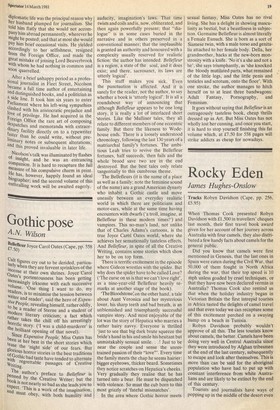Gothic pose
A.N. Wilson
Bellefleur Joyce Carol Oates (Cape, pp. 558 £7.50) Cult figures cry out to be derided, particularly when they are fervent sprinklers of the incense at their own shrines. Joyce Carol ates's portentousness has been getting increasingly irksome with each successive Volume. 'One thing I want to do, my readers, is to minimise the tension between writer and reader' said the hero of Expensive People, revealing himself, rather oddly, to be a reader of Sterne and a student of modern literary criticism; a fact which rather takes the chill off his arrestingly horrific story. CI was a child-murderer' is the brilliant opening of that novel). Since Expensive People, Miss Oates has been at her best in the short stories which tease the 'night side' of our fears. But glorious horror stories in the best traditions Of Goth bad taste have tended to alternate with regrettable passages of Creative Writing. The author's preface to Bellefleur is Penned by the Creative Writer; but the book is not nearly so bad as she leads you to expect. 'This is a work of the imagination, and must obey, with both humility and audacity, imagination's laws. That time twists and coils and is, now, obliterated, and then again powerfully present; that "dia logue" is in some cases buried in the narrative and in others preserved in a conventional manner; that the implausible is granted an authority and honoured with a complexity usually reserved for realistic fiction: the author has intended. Bellefleur is a region, a state of the soul, and it does exist; and there, sacrosanct, its laws are utterly logical'.
This stuff makes you sick. Even the punctuation is affected. And it is surely for the reader, not the author, to say whether a book is 'utterly logical'. It is all a roundabout way of announcing that although Bellefleur appears to be one long story, it is really a lot of interlaced short 'stories. Like the Mulliner tales, they all relate to different members of one eccentric family. But there the likeness to Wodehouse ends. There is a loosely understood chronology, following the last 130 years of a matriarchal family's fortunes. The ambitious Leah tries to revive the Bellefleur fortunes, half succeeds, then fails and the whole brood save two are in the end destroyed. But the best tales only relate tangentially to this cumbrous theme.
The Bellefleurs (it is the name of a place as well as a family; note the feminine sound of the name) are a grand American dynasty who inhabit a Gothic castle and move uneasily between an everyday realistic world in which there are politicians and motor-cars, while at the same time having encounters with dwarfs (4a troll, imagine, at Bellefleur in these modern times!') and vampires. This no-man's land, not unlike that of Charles Adams's cartoons, is the true Joyce Carol Oates world, where she achieves her sensationally tasteless effects. And Bellefleur, in spite of all the Creative Writing, contains some stories which show her to be on top form.
There is terrific excitement in the episode where Gideon wrestles with the spider. But why does the spider have to be called Love? (The curse on us is that we can't love right', as a nine-year-old Bellefleur heavily remarks at another stage of the book).
'The Bloodstone: on the other hand, a tale about Aunt Veronica and her mysterious lover, his sharp teeth and bad breath, is an unblemished and triumphantly successful vampire story. And most enjoyable of the lot was the story of Hepatica who marries a rather hairy navvy. Everyone is thrilled `just to see that big dark brute squeeze the bride's hand in his and smile his hesitant but unmistakably sensual smile. . .! Just to be near the couple and sense the unrestrained passion of their "love". Every time the family meets the chap he seems hairier: bigger eyebrows, thicker beard. Sometimes they notice scratches on Hepatica's cheeks. Very gradually they realise that he has turned into a bear. He must be dispatched with violence. So must the cub born to this most grizzly of 'fateful mismatches'.
In the area where Gothic horror meets sexual fantasy, Miss Oates has no rival living. She has a delight in showing masculinity as bestial, but a beastliness in subjection. Germaine Bellefleur is almost literally a Female Eunuch. She is born as a sort of Siamese twin, with a male torso and genitalia attached to her female body. Della, her grandmother, hacks at the new-born monstrosity with a knife. 'No it's a she and not a he', she says triumphantly, as 'she knocked the bloody mutilated parts, what remained of the little legs, and the little penis and testicles and scrotum, onto the floor'. With one stroke, the author manages to hitch herself on to at least three bandwagons: Adult Fantasy, Pornography, and Feminism.
It goes without saying that Bellefleur is an outrageously tasteless book, cheap thrills dressed up as Art. But Miss Oates has not wholly lost her cunning, and once you start, it is hard to stop yourself finishing this fat volume which, at £7.50 for 558 pages will strike addicts as cheap for nowadays. ,






































 Previous page
Previous page